Verification of the Influence of Processing History through Comparing High-Speed Melt Spinning Behavior of Virgin and Recycled Polypropylene
Abstract
:1. Introduction
2. Experimental Section
2.1. Preparation of Recycled PP Model Materials
2.2. High-Speed Melt Spinning
2.3. On-Line Measurement
2.4. Analysis of As-Spun Fibers
2.4.1. Tensile Test
2.4.2. Birefringence Measurement
2.4.3. Wide Angle X-ray Diffraction (WAXD) Analysis
3. Results and Discussion
3.1. Melt Spinning Behavior of Virgin and Recycled PP
3.2. Structure and Properties of As-Spun Fibers
4. Conclusions
Author Contributions
Funding
Institutional Review Board Statement
Informed Consent Statement
Data Availability Statement
Acknowledgments
Conflicts of Interest
References
- Ferdous, W.; Manalo, A.; Siddique, R.; Mendis, P.; Zhuge, Y.; Wong, H.S.; Lokuge, W.; Aravinthan, T.; Schubel, P. Recycling of landfill wastes (tyres, plastics and glass) in construction—A review on global waste generation, performance, application and future opportunities. Resour. Conserv. Recycl. 2021, 173, 105745. [Google Scholar] [CrossRef]
- Xu, E.G.; Ren, Z.J. Preventing masks from becoming the next plastic problem. Front. Environ. Sci. Eng. 2021, 15, 125. [Google Scholar] [CrossRef] [PubMed]
- Ford, H.V.; Jones, N.H.; Davies, A.J.; Godley, B.J.; Jambeck, J.R.; Napper, I.E.; Suckling, C.C.; Williams, G.J.; Woodall, L.C.; Koldewey, H.J. The fundamental links between climate change and marine plastic pollution. Sci. Total Environ. 2022, 806, 150392. [Google Scholar] [CrossRef] [PubMed]
- Jem, K.J.; Tan, B. The development and challenges of poly (lactic acid) and poly (glycolic acid). Adv. Ind. Eng. Polym. Res. 2020, 3, 60–70. [Google Scholar] [CrossRef]
- Hamed, I.; Jakobsen, A.N.; Lerfall, J. Sustainable edible packaging systems based on active compounds from food processing byproducts: A review. Compr. Rev. Food Sci. Food Saf. 2022, 21, 198–226. [Google Scholar] [CrossRef] [PubMed]
- Zhao, C.; Liu, M.; Du, H.; Gong, Y. The evolutionary trend and impact of global plastic waste trade network. Sustainability 2021, 13, 3662. [Google Scholar] [CrossRef]
- Tominaga, A.; Sekiguchi, H.; Nakano, R.; Yao, S.; Takatori, E. Advanced recycling process for waste plastics based on physical degradation theory and its stability. J. Mater. Cycles Waste Manag. 2019, 21, 116–124. [Google Scholar] [CrossRef] [Green Version]
- Schyns, Z.O.; Shaver, M.P. Mechanical recycling of packaging plastics: A review. Macromol. Rapid Commun. 2021, 42, 2000415. [Google Scholar] [CrossRef]
- Grigore, M.E. Methods of recycling, properties and applications of recycled thermoplastic polymers. Recycling 2017, 2, 24. [Google Scholar] [CrossRef] [Green Version]
- Yao, S.; Tominaga, A.; Fujikawa, Y.; Sekiguchi, H.; Takatori, E. Inner structure and mechanical properties of recycled polypropylene. Nihon Reoroji Gakkaishi 2013, 41, 173–178. [Google Scholar] [CrossRef] [Green Version]
- Yamaguchi, M.; Wagner, M.H. Impact of processing history on rheological properties for branched polypropylene. Polymer 2006, 47, 3629–3635. [Google Scholar] [CrossRef]
- Khanna, Y.P.; Reimschuessel, A.C.; Banerjie, A.; Altman, C. Memory effects in polymers. II. Processing history vs. crystallization rate of nylon 6—observation of phenomenon and product behavior. Polym. Eng. Sci. 1998, 28, 1600–1606. [Google Scholar] [CrossRef]
- Song, M.S.; Hu, G.X. Study on the relationship between the mechanical properties and processing for self-reinforced polymers: A method for estimating the theoretical strength of UHMWPE fiber. Polym. Test. 1991, 10, 367–378. [Google Scholar] [CrossRef]
- Seguela, R. Critical review of the molecular topology of semicrystalline polymers: The origin and assessment of intercrystalline tie molecules and chain entanglements. J. Polym. Sci. Part B Polym. Phys. 2005, 43, 1729–1748. [Google Scholar] [CrossRef]
- Litvinov, V.; Deblieck, R.; Clair, C.; Van Den Fonteyne, W.; Lallam, A.; Kleppinger, R.; Ivanov, D.A.; Ries, M.A.; Boerakker, M. Molecular structure, phase composition, melting behavior, and chain entanglements in the amorphous phase of high-density polyethylenes. Macromolecules 2020, 53, 5418–5433. [Google Scholar] [CrossRef]
- Tominaga, A.; Sekiguchi, H.; Nakano, R.; Yao, S.; Takatori, E. Thermal process-dependence of the mechanical properties and inner structures of pre-consumer recycled polypropylene. AIP Conf. Proc. 2015, 1664, 150011. [Google Scholar] [CrossRef]
- Alsabri, A.; Tahir, F.; Al-Ghamdi, S.G. Life-Cycle Assessment of Polypropylene Production in the Gulf Cooperation Council (GCC) Region. Polymers 2021, 13, 3793. [Google Scholar] [CrossRef]
- Zhang, C.; Liu, G.; Jiang, Q.; Yang, J.; Zhao, Y.; Wang, D. A WAXS/SAXS study on the deformation behavior of β-nucleated propylene–ethylene random copolymer subjected to uniaxial stretching. RSC Adv. 2015, 5, 44610–44617. [Google Scholar] [CrossRef]
- Tominaga, A.; Sekiguchi, H.; Nakano, R.; Yao, S.; Takatori, E. The Inner Crystal Structures and Mechanical Properties of Entrance Zone and End Zone of Injection Molded Articles in Blend System of Virgin and Pre-Consumer Recycled Resin. Kobunshi Ronbunshu 2017, 74, 225–232. [Google Scholar] [CrossRef]
- Shimizu, J.; Okui, N.; Kikutani, T. Simulation of dynamics and structure formation in high-speed melt spinning. In High-speed Fiber Spinning—Science and Engineering Aspects, 1st ed.; Ziabicki, A., Kawai, H., Eds.; John Wiley and Sons: New York, NY, USA, 1985; pp. 173–201. [Google Scholar]
- Dhadwal, R. Numerical simulation of a two-phase melt spinning model. Appl. Math. Modell. 2011, 35, 2959–2971. [Google Scholar] [CrossRef]
- García, B.E.; Zacarías, A.; Ferrer, V.H.; Vargas, R.O. Numerical simulation of the non-isothermal co-extrusion fiber spinning with flow-induced crystallization. J. Appl. Fluid Mech. 2018, 11, 1207–1215. [Google Scholar] [CrossRef]
- Takarada, W.; Sugimoto, K.; Nakajima, H.; Visser, H.A.; Gruter, G.J.M.; Kikutani, T. Melt-Spun Fibers from Bio-Based Polyester–Fiber Structure Development in High-Speed Melt Spinning of Poly (ethylene 2, 5-furandicarboxylate) (PEF). Materials 2021, 14, 1172. [Google Scholar] [CrossRef] [PubMed]
- Hahm, W.G.; Ito, H.; Kikutani, T. Analysis of necking deformation behavior in high-speed in-line drawing process of PET by on-line diameter and velocity measurements. Int. Polym. Process. 2006, 21, 536–543. [Google Scholar] [CrossRef]
- Yun, J.H.; Shin, D.M.; Lee, J.S.; Jung, H.W.; Hyun, J.C. Sensitivity of spinning process with flow-induced crystallization kinetics using frequency response method. Korean J. Chem. Eng. 2010, 27, 37–44. [Google Scholar] [CrossRef]
- Lee, J.S.; Shin, D.M.; Jung, H.W.; Hyun, J.C. Transient solutions of the dynamics in low-speed fiber spinning process accompanied by flow-induced crystallization. J. Non-Newton. Fluid Mech. 2005, 130, 110–116. [Google Scholar] [CrossRef]
- Takarada, W.; Ito, H.; Kikutani, T.; Okui, N. Studies on high-speed melt spinning of noncircular cross-section fibers. I. Structural analysis of as-spun fibers. J. Appl. Polym. Sci. 2001, 80, 1575–1581. [Google Scholar] [CrossRef]
- Cao, J.; Kikutani, T.; Takaku, A.; Shimizu, J. Nonisothermal orientation-induced crystallization in melt spinning of polypropylene. J. Appl. Polym. Sci. 1989, 37, 2683–2697. [Google Scholar] [CrossRef]
- Kolb, R.; Seifert, S.; Stribeck, N.; Zachmann, H.G. Simultaneous measurement of small- and wide-angle X-ray scattering during low speed spinning of poly(propylene) using synchrotron radiation. Polymer 2000, 41, 1497–1505. [Google Scholar] [CrossRef]
- Kikutani, T. Structure development in synthetic fiber production. In Handbook of Textile Fibre Structure Volume 1; Eichhorn, S.J., Hearle, J.W.S., Jaffe, M., Kikutani, T., Eds.; Woodhead Publishing: Cambridge, UK, 2009; pp. 157–180. [Google Scholar]
- Weir, M.P.; Johnson, D.W.; Boothroyd, S.C.; Savage, R.C.; Thompson, R.L.; King, S.M.; Rogers, S.E.; Coleman, K.S.; Clarke, N. Distortion of chain conformation and reduced entanglement in polymer–graphene oxide nanocomposites. ACS Macro Lett. 2016, 5, 430–434. [Google Scholar] [CrossRef] [Green Version]
- Lee, J.; Kim, E. Effects of microstructural changes by injection velocity variations on conductivity in Polyaniline-Based polymer blends. Polym. Plast. Technol. Eng. 2012, 51, 1181–1185. [Google Scholar] [CrossRef]
- Zhao, N.Y.; Lian, J.Y.; Wang, P.F.; Xu, Z.B. Recent progress in minimizing the warpage and shrinkage deformations by the optimization of process parameters in plastic injection molding: A review. Int. J. Adv. Manuf. Technol. 2022, 120, 85–101. [Google Scholar] [CrossRef] [PubMed]
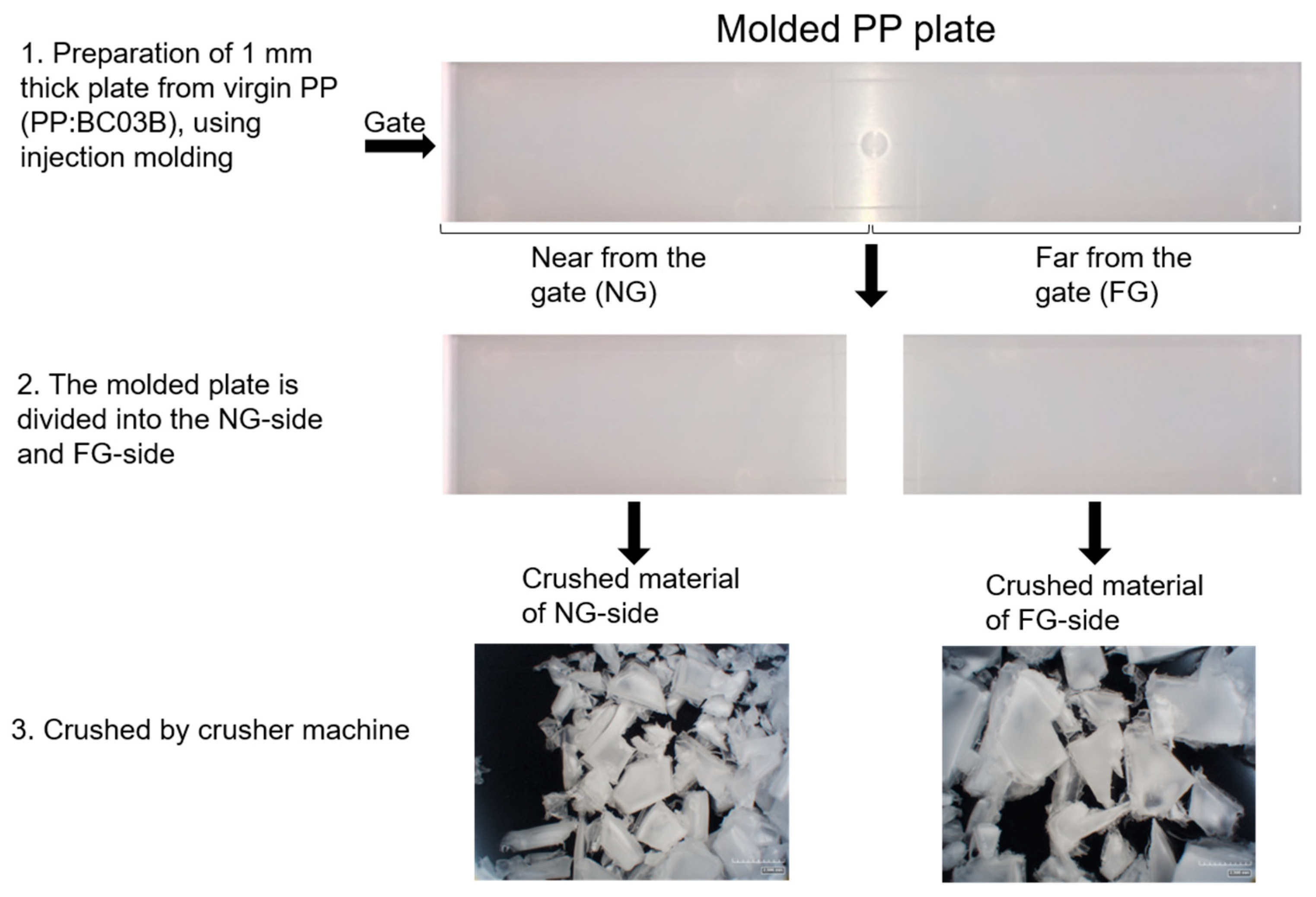
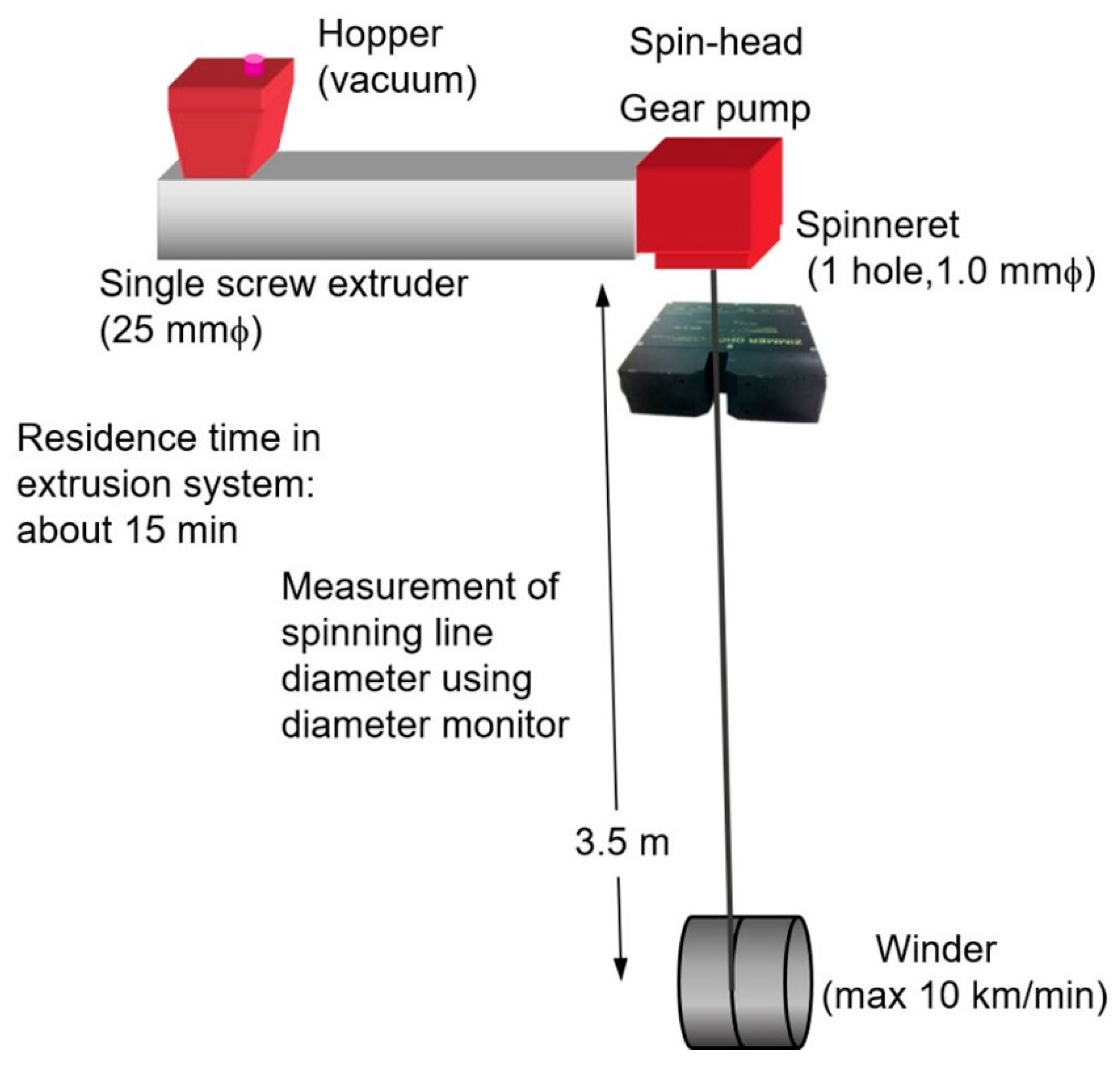
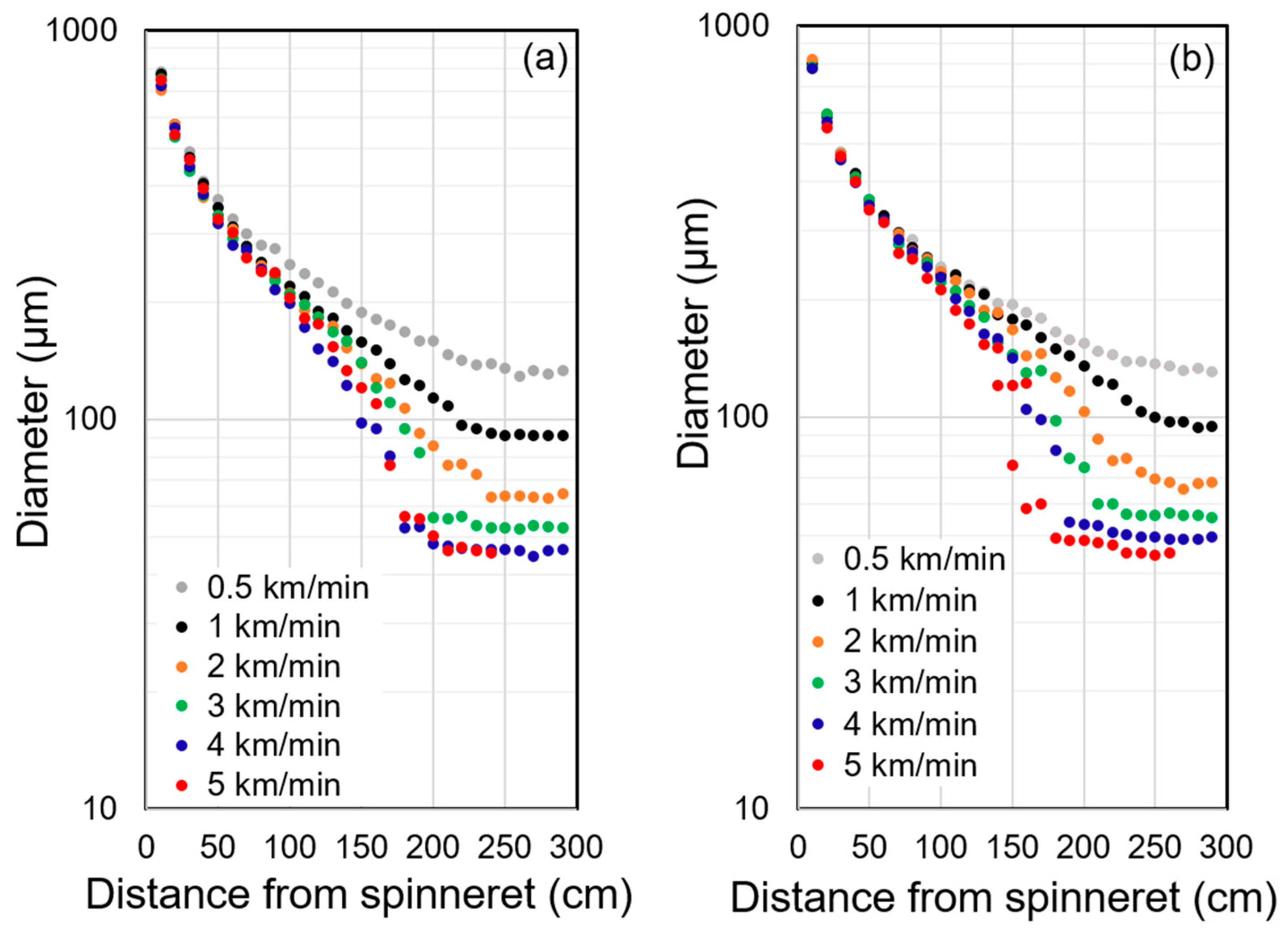





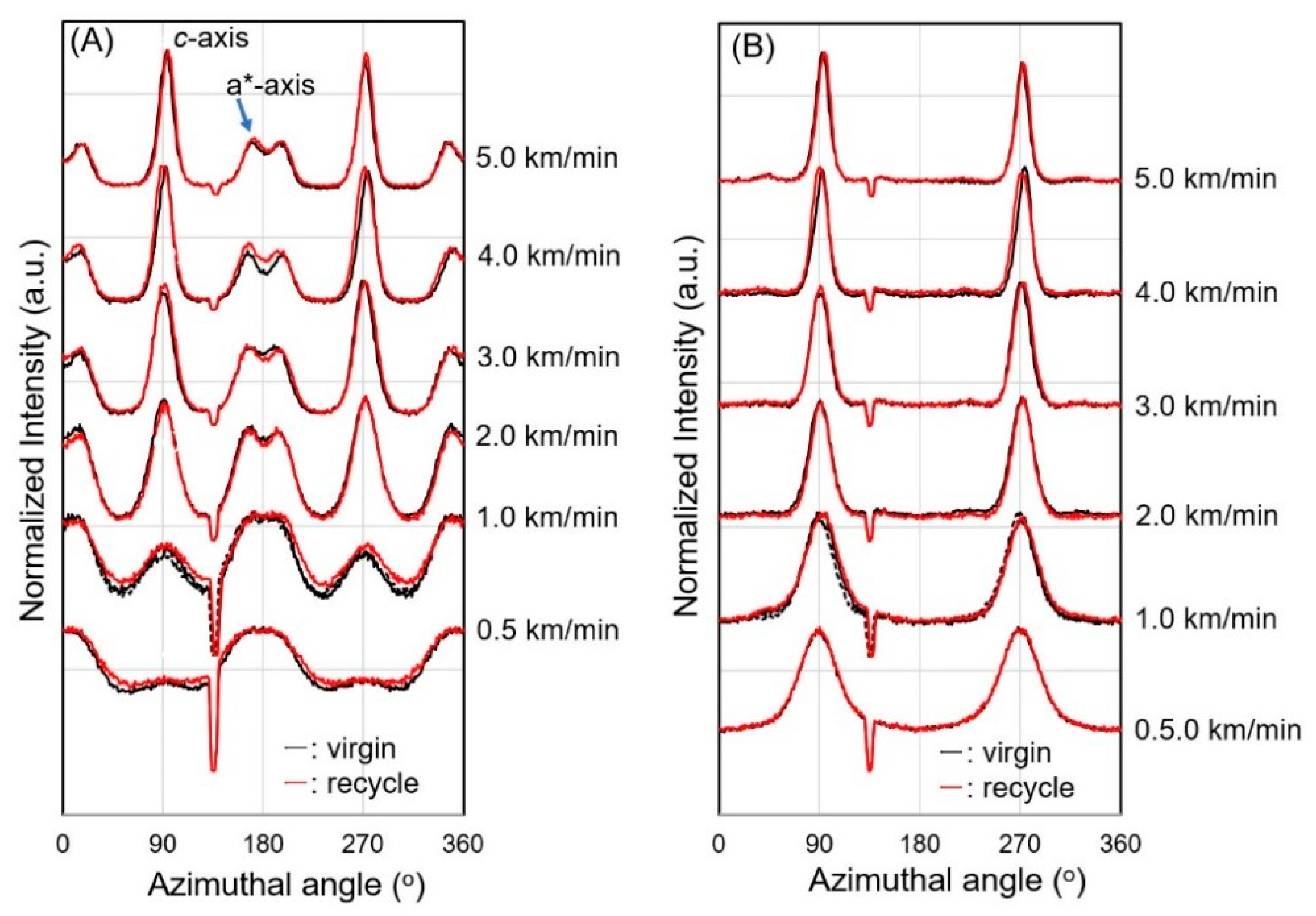
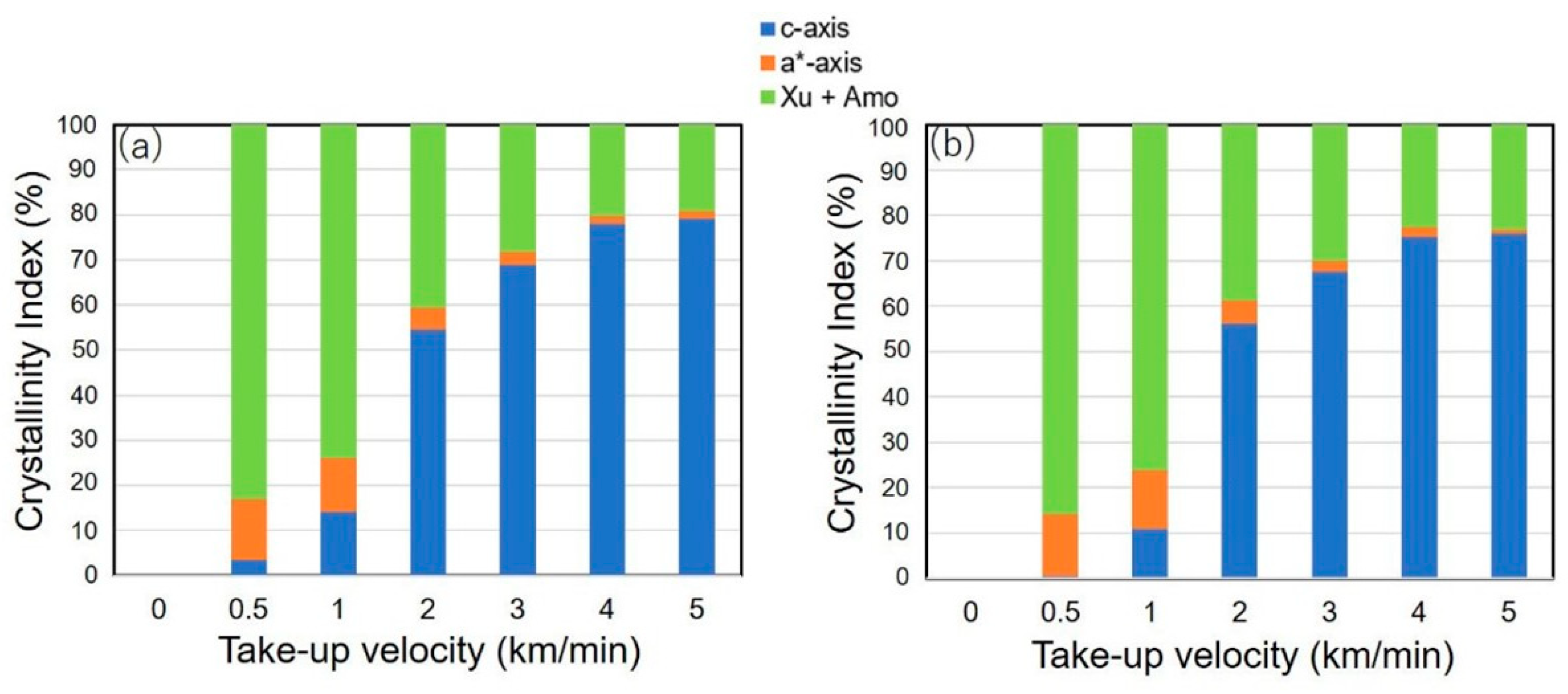
Publisher’s Note: MDPI stays neutral with regard to jurisdictional claims in published maps and institutional affiliations. |
© 2022 by the authors. Licensee MDPI, Basel, Switzerland. This article is an open access article distributed under the terms and conditions of the Creative Commons Attribution (CC BY) license (https://creativecommons.org/licenses/by/4.0/).
Share and Cite
Takarada, W.; Barique, M.A.; Kunimitsu, T.; Kameda, T.; Kikutani, T. Verification of the Influence of Processing History through Comparing High-Speed Melt Spinning Behavior of Virgin and Recycled Polypropylene. Polymers 2022, 14, 3238. https://doi.org/10.3390/polym14163238
Takarada W, Barique MA, Kunimitsu T, Kameda T, Kikutani T. Verification of the Influence of Processing History through Comparing High-Speed Melt Spinning Behavior of Virgin and Recycled Polypropylene. Polymers. 2022; 14(16):3238. https://doi.org/10.3390/polym14163238
Chicago/Turabian StyleTakarada, Wataru, Mohammad A. Barique, Tatsuma Kunimitsu, Takao Kameda, and Takeshi Kikutani. 2022. "Verification of the Influence of Processing History through Comparing High-Speed Melt Spinning Behavior of Virgin and Recycled Polypropylene" Polymers 14, no. 16: 3238. https://doi.org/10.3390/polym14163238






